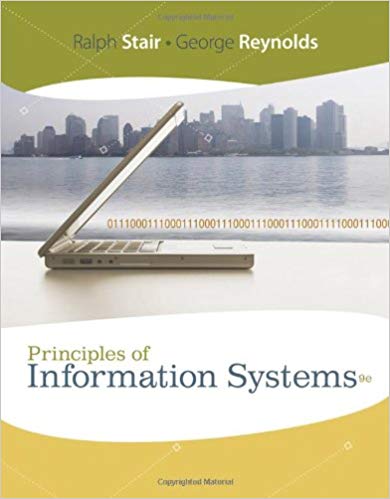Question
There are many ways to forecast the future. In many companies (especially small ones), the entire process is subjective, involving improvised methods, intuition, and years
It should be noted that a forecast is an input to support decision making under uncertainty. Forecasts are created by a statistical model and/or by human judgment. A statistical model is nothing more than an algorithm, often built into a spreadsheet model or other software, that converts data into a forecast. Of course, choosing the algorithm an organization uses to forecast and how this algorithm is implemented often requires the use of human judgment as well. Human judgment is therefore the intuition and knowledge that decision makers can employ to convert all available data and tacit information into a forecast (Siemsen & Kolassa, 2016).
Steps to make forecasts
According to Render et al. (2018) the following steps help in the development of a forecast system. While steps 5 and 6 may not be relevant if the quantitative model is selected in step 4, the data is certainly needed for quantitative forecasting models.
1. Determining the use of the forecast: what goal are we trying to achieve? 2. Select the items or quantities to forecast. 3. Determine the time horizon of the forecast: 30 days (short term), 1 month to a year (medium term), or more than a year (long term)? 4. Select the forecast model or models. 5. Gather the data or information necessary to make the forecast. 6. Validate the forecast model. 7. Make the forecast. 8. Implement the results. These steps indicate in a systematic way how to start, design and implement a forecasting system. When the forecast system is used to generate forecasts periodically, the data must be collected routinely, and the actual calculations or procedures used to make the forecast can be done automatically.
Types of forecasts
There are three types of forecasts: qualitative models, time series models, and causal models.
qualitative models
1. Qualitative models attempt to incorporate subjective or opinion factors into forecast models. Expert opinions, individual experiences and judgments, or other subjective factors are often taken into account.
2. Delphi method: Iterative group process where respondents provide information to decision makers. 3. Executive Opinion Panel: Collects the opinions of a small group of senior managers, possibly using statistical modeling for analysis. 4. Sales Force Composite: Allows individual salespeople to estimate sales in their region and data is compiled at the district or national level. 5. Consumer Market Survey: Information is requested from customers or potential customers regarding their purchasing plans.
Time series models
A time series is a sequence of similar measurements taken at regular time intervals. An inherent assumption in time series analysis is that the past of a series contains information about the future of the same series. Time series models attempt to predict the future based on the past. Common time series models are:
1. Moving average. 2. Exponential smoothing. 3. Trend projections. 4. Decomposition.
Regression analysis is used in trend projections and a type of decomposition model.
Causal models
Causal models use variables or factors that can influence the quantity being forecast. The goal is to build a model with the best statistical relationship between the variable being forecast and the independent 2. Variables. Regression analysis is the most common technique used in causal modeling.
Time series forecast models
A time series is based on a sequence of equally spaced data (weekly, monthly, quarterly). Forecasting with time series data implies that future values are predicted only from historical data for that variable and that other variables are ignored, regardless of their potential value.
Components of a time series
Four common components of a time series have been identified:
1. Trend (T) is the gradual up or down movement of data over time. 2. Seasonality (S) is the pattern of demand fluctuation above or below the trend line, which is repeated at regular intervals. 3. Cycles (C) are patterns in annual data that occur every certain number of years. 4. Random Variations (R) are "jumps" in the data caused by chance and unusual situations; they do not follow a discernible pattern.
I. The purpose of this journal is to reflect on and about the concepts and learning that emerge from the work of the first three modules. This process will help you in your self-analysis and promote your self-assessment.
II. After completing the week's assignments, reflect on the course and answer the questions below.
1. So far, in this course I have learned... 2. The topics studied in the first three modules of the course will help me to... 3. In my professional practice I will be able to apply what I have learned when...
Step by Step Solution
3.45 Rating (152 Votes )
There are 3 Steps involved in it
Step: 1
So far in this course I have learned I have learned about various forecasting methods and techniques including qualitative models time series models a...
Get Instant Access to Expert-Tailored Solutions
See step-by-step solutions with expert insights and AI powered tools for academic success
Step: 2

Step: 3

Ace Your Homework with AI
Get the answers you need in no time with our AI-driven, step-by-step assistance
Get Started


